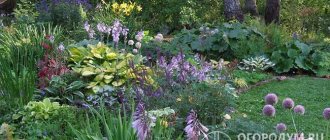It is quite difficult to improve shady places in the garden. The fact is that a relatively small number of crops are known that grow and develop normally in such conditions. If a shady place is located near a large tree, then the soil in such a place, as a rule, is not highly fertile and also has high humidity. To successfully landscape such a place, you need to think carefully. To arrange shady ledges or corners located in the northern part of the garden, it is recommended to use fern, ivy or periwinkle. Such crops feel great even in very dark areas. If you want more variety, then you can look among other shade-tolerant crops, but it is better to choose perennials that are unpretentious to growing conditions.
There are quite a lot of crops that grow well in sunny areas. But you will have to look for shade-loving varieties. At the same time, most species can grow in a partially shaded place with poor sunlight, but the bushes do not bloom so luxuriantly or the foliage becomes faded. Crops planted near shrubs and trees or growing near the northern wall of a building are found in precisely these conditions.
Ferns
Ferns thrive in a shaded area, but they need moderately moist soil. The following types of ferns are most popular among gardeners:
- male shieldweed;
- common millipede;
- the bladder is fragile;
- common ostrich;
- multirow spinous.
Bladder brittle
Common ostrich
Brittle bladderwort
What plants to plant in shady areas
Aquilegia
The unpretentious perennial aquilegia, or columbine, is suitable for decorating individual areas of the garden. Shade-tolerant flowers reproduce by seeds, growing into bushes with beautiful carved leaves.
Aquilegia: YouTube/Yana Fedorova Popular video
Lush flowering of aquilegia begins only in the third year after sowing the seeds. The plant blooms for 20–30 days. Individual flowers of irregular shape grow on leafless stems, rising 0.5 m above the leaf rosette. Different types of aquilegia have petals of white, red, blue, pink and other shades.
The corolla of the flower has a special structure: the petals form a funnel, and spurs grow from behind. Terry hybrids have more than five petals. Aquilegia seedlings are unpretentious to the soil, but require regular watering.
Shade-loving plants are suitable for decorating gardens and built-up summer cottages. They decorate borders, fence lines, and shaded flower beds. Planting shade-tolerant plant species on the site simplifies garden care and makes remote corners original due to unusual greenery and long-term flowering.
Original article: https://www.nur.kz/household/garden/1849306-tenelubivye-rastenia-dla-sada-varianty-dla-posadki/
Sod plants
Below we will describe in detail perennial ground cover plants that cover the ground and are shade-tolerant.
European hoofweed, ivy and periwinkle
European ungulate
Ivy
Periwinkle
Ivy, Common Periwinkle and European Clefthoof do not need much light to grow properly. Nutritious soil with high humidity is best suited for growing them, but they can grow in worse conditions. Such crops, even when grown in a shady place, grow and develop within normal limits.
Creeping tenacious
Such a perennial plant as creeping tenacious grows in large groups. It forms creeping shoots under the soil surface, which is why it is often used to protect the soil from landslides. The tenacious plant grows well in shade.
During flowering, the bush is decorated with small blue flowers, which are part of the spike-shaped inflorescence. Flowering occurs in May–August. Varieties with reddish-brown foliage are often grown in gardens.
Fragrant bedstraw
The shade-tolerant fragrant bedstraw blooms in April, and flowering ends in June. Its small flowers are collected in cluster-shaped inflorescences. Bedstraw has an aroma similar to hay.
Pachysandra apex
Such an evergreen plant as pachysandra apex is also called Japanese milk. Flowering is observed in May, and the flowers do not have any decorative value. This shade-loving crop can be used to improve the area under trees. The bushes grow strongly, covering the ground with a beautiful green carpet.
Spleen
Belonging to the Saxifraga family, the shade-tolerant spleen has both perennial and annual varieties. This culture received such an unusual name because it is used for diseases of the spleen. Perennial varieties prefer to grow in moist soil. Their shoots are decorated with evergreen leaf blades that are leathery to the touch. Flowering is observed in May; small star-shaped flowers appear on the bush. They are painted white, with a red central part. The flowers are part of loose panicle-shaped inflorescences.
Saxifraga shadow
Perennial saxifrage shady has a small compact bush. It often forms a rather extensive turf that does not bloom. This plant is most widespread in the Northern Hemisphere. Lush inflorescences consist of small pink flowers. This flower prefers to grow in partial shade, and nutritious and moist soil is most suitable for it. Saxifraga can form dense, extensive thickets that are highly decorative.
Plants for shade and partial shade. Shady garden
Shade-tolerant vines and ampels
Climbing, shade-loving and shade-tolerant plants look very attractive in hanging baskets, planters and baskets. Asparagus pleases with its bright openwork foliage, chlorophytum cheerfully produces “babies”, striped zebrins flash.
Assortment of hanging plants for dark rooms:
- Tradescantia;
- plectranthus;
- chlorophytums;
- asparagus;
- ivies.
This group of plants is suitable for rooms with artificial lighting and northern windows. When choosing hanging types, pay attention to the general pattern. Indoor flowers with monochrome leaves are more shade-tolerant than variegated ones.
Common indoor ivy
A house flower with leathery green leaves can be grown in the bathroom. It should be taken into account that a lot of water evaporates during showering and bathing. Therefore, the humidity in the room is higher than in other rooms.
Ivy loves warmth and moisture, tolerates shading, and adapts to artificial lighting. Hanging, densely leafy shoots look great on high shelves or in hanging plant pots.
Syngonium
Species of the genus Syngonium are distributed in the tropics and subtropics of America. These are large vines, usually growing as one long shoot. Modern hybrids differ in their type of growth - they are more compact, in the form of bushes or ampels.
Syngonium with monochromatic green leaves is more shade-tolerant. Variegated varieties are partially shade-tolerant.
Philodendron
The green climbing plant has heart-shaped leaves and tolerates low light in the corners of the room. Partial shade on a wall next to or opposite a window is an ideal place for a philodendron.
Philodendron can be grown in the kitchen, bathroom. Leaves purify and disinfect the air, trap gases that are released when burning gas or coal.
Asparagus
Most asparagus species prefer diffused light and cannot tolerate direct rays. They are highly decorative due to their delicate greenery and creeping shoots. It is convenient to grow asparagus in hanging baskets, attaching them to the wall.
Considering that in the autumn-winter period the flower needs rare watering, placing it on the wall does not cause any special problems.
Herbs that tolerate shade well
In shaded areas, some herbaceous crops do quite well. Shade-loving herbs will be described in more detail below.
Ozhika forest and snow
Ozhika snowy
Ozhika forest and snowy is a perennial shade-tolerant plant that is quite popular among gardeners. It is often planted under bushes or trees. However, the hedgehog may die if it remains in deep shadow all the time.
Ozhika forest
Forest grass is an evergreen plant whose foliage is covered with long hairs.
Fescue
Swamp fescue, or gray fescue, or low sedge is a semi-evergreen or evergreen perennial plant belonging to the Poaceae family. It grows well in shaded areas.
Structure
Shade-tolerant plants (sciophytes) are constantly in conditions of strong shading, so physiologically they have a relatively low intensity of photosynthesis. In this regard, the leaves of such plants have the following anatomical and morphological features: the columnar and spongy parenchyma is poorly developed, the intercellular spaces are increased, and the cells themselves contain a small number of chloroplasts (10-40), the surface area of which is in the range of 2-6 cm2 per 1 cm2 leaf area. The epidermis is very thin, single-layered, its cells may contain chloroplasts (which heliophytes do not), and the cuticle is also thin. Stomata on the leaves are located on both sides with a slight predominance on the reverse side. Sciophytes have less chlorophyll than heliophytes. In shade-tolerant plants, physiological processes such as transpiration and respiration occur with less intensity. The intensity of photosynthesis, having reached its maximum, does not increase with increasing illumination, and may even decrease in bright sunshine.
When growing in bright sun, anthocyanin can be formed in the cells of some shade-tolerant plants, which colors the leaves and stems of plants in a reddish or brownish color, which is uncharacteristic for them in natural habitats. In other plants, on the contrary, a paler leaf color is observed. Shade-tolerant plants have thin leaves, and the chloroplasts and cells in them are large.
Low shade-loving perennials
Fragrant violet
Garden plots are often decorated with shade-tolerant fragrant violets. Its small purple-blue flowers have a very pleasant aroma. The plant is unpretentious and spreads quickly. Flowering is observed in March–May. When planting violets, you need to remember that it spreads very quickly throughout the area and can easily occupy an area not intended for it.
Lungwort
The height of the red lungwort is about 0.3–0.4 m. Flowering is observed from March to May, at which time the bushes are decorated with small red-brick flowers. The crop can be planted under shrubs or trees.
Sugar lungwort
Sugar lungwort is grown in shade and partial shade. She prefers nutritious soil with high humidity. Its dark green, showy leaf blades have specks of a contrasting silvery-white hue. When formed, the flowers have a red-coral tint. But when they open, their color changes to blue, pink or purple. Flowering - in March–April. This lungwort forms lush and dense bushes that cover the soil.
Noble liverwort
Liverwort is an evergreen herbaceous plant. It forms low carpets. In favorable conditions, the foliage remains throughout the winter period: in the upper part the plate is green, and in the lower part it is light yellow. Liverwort is often planted under tall trees to create a green carpet.
Lily of the valley
Lilies of the valley prefer to grow in shady areas. Their reproduction occurs by rhizomes. However, in dense shade, lily of the valley blooms sparingly, but the foliage grows well. To plant this crop, you need to choose a place that will be in the shade for at least half the day. The bushes are decorated with small bell-shaped flowers with a characteristic scent.
Garden hellebore
Garden hellebore is one of the first to bloom with the onset of spring in the garden. If the winter period is relatively warm, the flowers may bloom as early as December. This plant is planted in shady areas, and the chosen place should be secluded and with high humidity.
Doronicum eastern
Doronicum orientalis blooms in May, and the bush is decorated with yellow-golden flowers. Loose garden soil with high humidity is best suited for it. It is recommended to choose not too dark areas for planting that are in partial shade.
Primrose fine-toothed
The shade-tolerant fine-toothed primrose does not grow well in sunny areas and may even die. A slightly shaded area is perfect for it. The soil chosen is loamy, neutral and nutritious, but it must be constantly moist (even in summer).
What to Plant in the Shade











